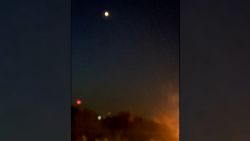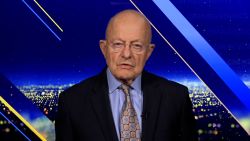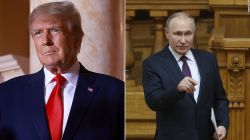Iran announced Wednesday it was partially withdrawing from a landmark nuclear deal, marking a serious escalation in Tehran’s faceoff with the United States.
President Hassan Rouhani said in a televised speech that Iran would reduce its “commitments” to the Joint Comprehensive Plan of Action, or JCPOA, but would not fully withdraw, amid heightened pressure from the US in recent weeks.
From this week on, Iran will keep its excess enriched uranium and heavy water, rather than sell it to other countries as previously agreed to limit its stockpile, Rouhani said.
He also said drastic measures would be implemented unless the remaining signatories of the deal – Britain, China, France, Germany and Russia – eased restrictions on Iran’s banking and oil sectors in the next 60 days. The measures include removing caps on uranium enrichment levels, and resuming work on its Arak nuclear facility.
The move comes a year after the US unilaterally withdrew from the deal, over the stringent objections of other signatories. In a press conference today, Iranian Foreign Minister Mohammad Javad Zarif described the US’s exit from both the Intermediate-Range Nuclear Forces (INF) treaty and the JCPOA as “dangerous,” according to Iranian semi-official FARS news.
Following Rouhani’s announcement, the White House responded with new sanctions on Iran’s iron, steel, aluminum, and copper sectors. In a statement, US President Donald Trump warned that “Tehran can expect further actions unless it fundamentally alters its conduct.”
‘In order to get the world to jump’
US Secretary of State Mike Pompeo said Wednesday that Iran’s letter outlining its withdrawal was “intentionally vague,” adding that its threats to implement further action were “in order to get the world to jump.”
The US will have to wait and “see what Iran’s actions actually are,” Pompeo said during a joint press briefing with UK Foreign Secretary Jeremy Hunt in London.
Hunt meanwhile – whose country has repeatedly pledged its support for the deal – warned Iran “there will be consequences” if it does not comply with the agreement.
“I’m sure I speak for my European colleagues in that respect as well. This is a very big moment for Iran,” added Hunt.
Under the nuclear deal, Iran was permitted to stockpile limited amounts enriched uranium and heavy water produced in that process, exporting any excess. Doing so has become extremely difficult after the US revoked waivers that allowed Iran to export those excess stockpiles, effectively forcing Iran to halt enrichment or ignore the limits, which it is now doing.
Rouhani accused “hardliners” in the US of working to undermine the deal, saying it was “in the interests of the region and the world, but not the enemies of Iran, therefore they spared no effort since 2015 to undermine (the deal).”
Signatories react
The announcement puts European signatories to the agreement in a delicate position – either side with the Trump administration and walk away from the deal, or preserve the pact by caving in to Iranian calls to ease restrictions on banking and oil trade, despite the threat of US sanctions.
Over the weekend, the European countries again criticized the Trump administration’s re-imposition of sanctions, and said Iran had continued to comply with the terms of the deal.
The Kremlin also placed the blame for Iran’s partial withdrawal on Washington’s “ill-conceived steps” to pressure Tehran, spokesperson Dmitry Peskov said during a Wednesday press briefing.
China’s Ministry of Foreign Affairs Spokesperson, Geng Shuang, on Wednesday called on “all relevant parties to exercise restraint, strengthen dialogue, and avoid escalating tensions.”
Trump turnaround
The deal with Iran was widely hailed as a major diplomatic victory by Barack Obama’s administration, but one that was immediately criticized by his successor.
Last year, US President Donald Trump withdrew his country from the deal, saying it was “defective at its core” and reimposing sanctions. Since then, anti-Iran hawks within his administration, particularly Secretary of State Mike Pompeo and national security adviser John Bolton, have been ramping up pressure on Tehran.
This week, Pompeo made a surprise visit to Iran’s neighbor Iraq, where he accused Tehran of making military moves, including transporting short- and medium-range ballistic missiles aboard boats in the Persian Gulf, much of which falls within Iranian territorial waters or the country’s Exclusive Economic Zone.
Speaking to reporters, Pompeo said he discussed the “threat stream we had seen” from Iran and stressed “the importance of Iraq ensuring that it’s able to adequately protect Americans in their country.”
The US Defense Department is now considering sending additional firepower to the region, including anti-missile defense systems, according to several US officials with knowledge of the situation.
Pompeo is a proponent of a “maximum pressure” approach to Iran, and in the past has appeared to support regime change in Tehran, such as in a speech last year in which he said the goal of the US was “to get the Iranian regime to behave like a normal nation.”
Since then, the US has reintroduced all nuclear-related sanctions among a slew of other punitive measures. In the past month, it has moved to cut off Iran’s oil revenues, its chief source of foreign income, put curbs on its civilian nuclear work, and designated Iran’s Revolutionary Guard Corps, the elite military group with deep political and economic influence, as a terrorist entity.
What was the original deal?
The JCPOA was intended to limit Iran’s civilian energy program – thereby preventing it from developing nuclear weapons at some point in the future – in exchange for relief from sanctions that were crippling the Iranian economy.
The deal was struck in Vienna following two years of intensive talks orchestrated by the Obama administration. It was signed by Iran and six other nations in 2015 – the United States, the United Kingdom, France, Russia, China and Germany. The accord was also enshrined in a UN Security Council resolution, making it international law.
Under the deal, the Iranian government agreed to three key things:
Reducing the number of its centrifuges by two-thirds (centrifuges are tube-shaped machines used to enrich uranium, the material necessary for nuclear power); slashing its stockpile of enriched uranium by 98%; and capping uranium enrichment at 3.67% – enough to continue powering parts of the country’s energy needs, but not enough to ever build a nuclear bomb.
In addition, Iran was required to limit uranium research and development, and allow inspectors from the International Atomic Energy Agency (IAEA) certain access to its civilian nuclear facilities.
In return for its compliance, all nuclear-related sanctions on Iran were lifted in January 2016, reconnecting the country’s stagnating economy with international markets.
Iran is a signatory to the Nuclear Non-Proliferation Treaty and has always maintained that its nuclear research is purely civilian in nature.
CNN’s Steve George and Nicole Gaouette contributed reporting.




















